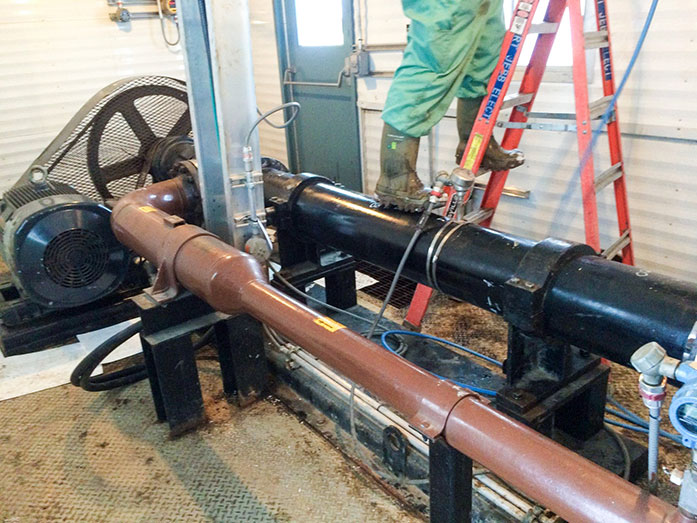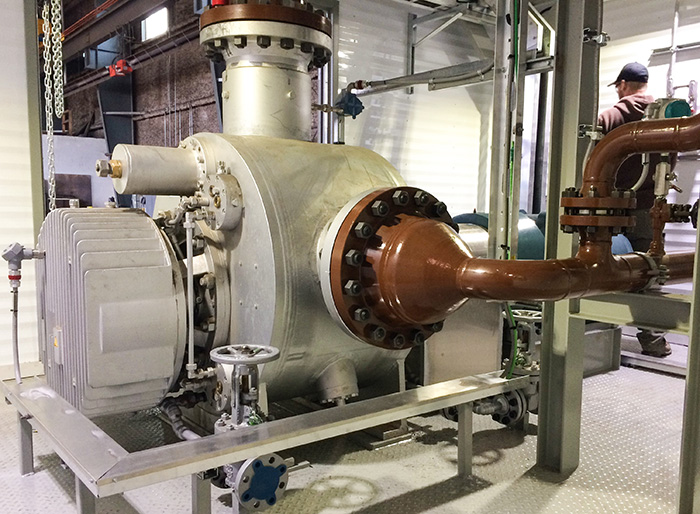Pump system improvements boost plant profitability, targeting issues of process uptime, maintenance and energy costs. Pump optimization should be part of any ongoing improvement process, as it results in a positive impact on a facility’s pump and process reliability over time. When all parts of the system are taken into consideration, these improvements can represent millions of dollars in savings. These savings can vary by industry type and plant size, but the impact on total cost of ownership (TCO), downtime and efficiency can make or break any bottom line.
In today’s facilities, preventive and predictive maintenance practices are central to the overall pumping process. These maintenance routines help predict mechanical failures and in turn prevent catastrophic breakdowns. When smart monitoring and control technologies are combined with traditional maintenance practices, facilities are empowered to maintain equipment in like-new condition.
Smart Technology to Prevent & Predict Failures
Modern condition monitoring technologies are central to optimizing the performance of rotating equipment and an ideal solution to prevent unplanned downtime. Traditional condition monitoring techniques and budget constraints force practitioners to make difficult choices as to which pieces of equipment they can focus on while using a time-based maintenance plan—or the “fix it when it breaks” mentality—for less critical assets.
Even in those plants that do perform periodic predictive maintenance inspections, the time between inspections can be a month or sometimes up to a year. Many machine problems can develop and progress into catastrophic failure during this time, making the predictive maintenance program ineffective and causing an increase in maintenance time, costs and downtime.
Historically, continuous monitoring of machinery health has come with a big price tag that couldn’t be justified except on the most critical assets. Today’s sensors and Bluetooth technologies offer a low-cost alternative that continuously tracks key machinery health parameters including overall vibration and temperature, and allows users to access that trend data during routine inspections.
These technologies offer improved utility and reduced cost compared to a typical walk-around monthly program, allowing users to collect high quality, repeatable, vibration and temperature data more quickly, while remaining at a safe distance. This gives operators and skilled vibration analysts the ability to focus on solving chronic problems instead of routine monitoring. In addition, continuous data collection allows for diagnosis of transient- and process-related problems, which are traditionally nearly impossible to spot with monthly or quarterly data collection cycles. With increased safety, early detection, less time and more data, condition-monitoring tools are critical to the success of any predictive or preventive maintenance program, which better fits the needs of today’s reliability practitioner.
Control solutions such as variable speed drives (VSDs) are another option when assessing pump systems and selecting improvements. In addition to energy savings and lower operating costs, VSDs offer real-time pump control and protection while also providing valuable process insight. Load information is transferred from the pump shaft to the motor shaft, interpreted by the VSD and used to calculate pump performance data. Users can utilize that information to estimate pump flow and total head, etc., while protecting pumps against conditions like dry running, minimum flow and cavitation without the need for external instruments.
Through pump-specific algorithms, VSDs accurately predict where the system is operating on the pump curve, which helps identify upset conditions, protects pumps from premature failure and details the efficiency of the pump and pump system. With this information users have the option to shut down or warn the customer that the equipment is under performing.
By protecting against unplanned pump failure, VSDs can eliminate unplanned repair activities and ultimately, give deeper insight into how the pump operates, allowing you to make better decisions on how to control them, in turn increasing control, safety and reliability.
 Images 1. Before a pump upgrade. (Images courtesy of ITT Corporation.)
Images 1. Before a pump upgrade. (Images courtesy of ITT Corporation.)Upgrading Old or Under-performing Pumps
In addition to the latest technology available in preventing and predicting pump-system failures, another option to improve the overall pump system is upgrading old or under performing pumps.
Pump modifications can help alleviate these issues to meet current standards and process management needs—turning old, obsolete, outdated or inefficient pumps into a like-new condition, rebuilding them to current specifications and OEM standards, and allowing them to once again operate at best efficiency.
When a facility makes the decision to update one or several pumps in a system, operators will inevitably see improved performance and reduced downtime. This is because the upgraded pumps will run closer to best efficiency point (BEP), resulting in smoother pump operation with less vibration and longer bearing and seal life. As pumps become more efficient, less energy is wasted in the pumping process and long-term electrical costs see a positive impact as well.
These updates deliver performance improvements through hydraulic, mechanical and material modifications and come in many forms: a complete replacement to existing equipment, while keeping the existing impeller and casing; upgrading the seal interface; or rebowling a pump, to name a few. With the aim of being more economical than a complete new pump, rebowling a pump can be the solution for many problems with no disturbance to the existing piping and re-using some of the original parts such as the discharge head, mounting plate and the driver.
While sometimes it is necessary to replace a pump if the condition of the equipment is beyond repair, upgrading is a valid option and one that is key to any preventative maintenance strategy. When pumps do not operate properly, it results in excess energy in the form of vibration, heat and noise, which become a destructive force that contributes to pump and process unreliability. As a result, pump systems routinely have the highest overall maintenance cost compared to other motor systems.
But upgrades and added technologies can be the solution.
 Images 2. After a pump upgrade. Pump modifications can help alleviate issues of old, underperforming or inefficient pumps—turning them into like-new condition, rebuilding them to current specifications and OEM standards, and allowing them to once again operate at best efficiency.
Images 2. After a pump upgrade. Pump modifications can help alleviate issues of old, underperforming or inefficient pumps—turning them into like-new condition, rebuilding them to current specifications and OEM standards, and allowing them to once again operate at best efficiency.Reviewing Total Cost of Ownership
From tools like condition monitors and VFDs to assessing the need for pump upgrades, a full approach to pump system improvement can lead to performance and safety enhancements, as well as total cost of ownership
(TCO) savings.
TCO is the financial estimate of all costs in acquiring, commissioning, operating, maintaining and disposing of a product or system for a specified period of time. While initial cost of equipment is one of the largest decision factors for customers, it typically represents less than 10 percent of TCO. Energy, maintenance, operational and downtime costs, however, represent more than 60 percent of hard costs. Despite their weight, these factors are rarely considered during the selection process, but are the factors that can be addressed and brought under control during equipment life. Effective preventive and predictive maintenance strategies are key in reducing TCO and gaining long-term value from your pump system.
Performing equipment health analyses is an essential step in efficient pump processes. Identifying the sources of poor reliability will help recommend the right action plan within the predictive and preventive maintenance strategy.


